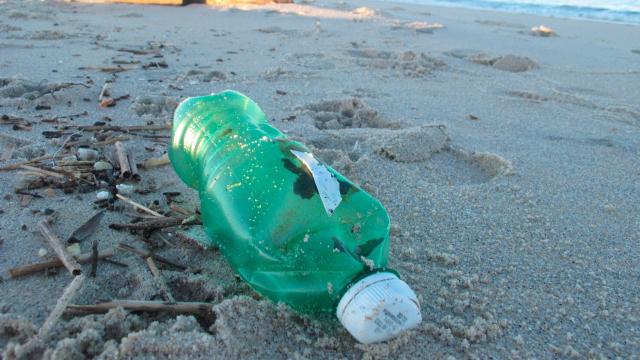It’s overwhelming to think about how polluted our oceans are — so much so that it’s increasingly tempting to think of technological solutions to clean it all up. Two new studies shed light on what, exactly, happens to plastic once it enters the ocean, and how some natural processes may be helping to break a lot of it down — including bacteria that can actually eat the plastic itself. But, the scientists say, we should be careful in thinking it’s possible to harness those processes as a quick fix for the mess we’ve already made.
The two studies, published in the January and February issues of Marine Pollution Bulletin, are from a team of researchers at the Royal Netherlands Institute for Sea Research, the country’s national oceanographic research institute. They address what’s known as the missing plastic paradox — the question of where, exactly, all the trash we dump into the ocean goes.
We funnel about 8 million tons of plastic into the ocean each year, at a rate of one dump trucks’ worth every hour — an amount so large it’s almost incomprehensible. But another, lesser-known detail about all this trash is that we’re actually missing quite a lot of it: We’ve only been able to locate around 1% of what should be there on the ocean’s surface and washed up on beaches. Natural processes, scientists have long theorised, may be at play here in helping to break down plastics and dissolve them into the water.
The first study from the Institute, published in January, looks at one of these possible explanations: the Sun itself.
“Just as someone might get a sunburn at the beach, UV light also deteriorates the molecular structure of plastic polymers,” lead author Annalisa Delre, a PhD student at Utrecht University, told Earther in an email. “It basically rips the long carbon chains apart into smaller ones.”
To get a better understanding of sunlight’s role in plastic degradation, Delre and her colleagues put various types of pieces of virgin plastic (plastic fresh from the production plant) as well as plastic taken from the sea surface of the Great Pacific Garbage Patch into sea water, then irradiated them with UV light to simulate marine conditions. They measured the amount of compounds that degraded from the plastic, calculating that UV light degrades plastic at a rate of about 2% each year.
“Doesn’t sound mind-blowing, right?” Delre said. “But consider, this happens year after year after year… So, a piece of plastic released decades ago can then already be gone, while one that was released last year [is] not.” Based on these observations and other research into where ocean plastic goes, Delre and her team created a model that showed sunlight could have already degraded up to 20% of the plastic that humans have put into the world’s oceans.
It’s not just the Sun working on degrading all that plastic. One month after Delre’s study was published, her colleague at the Institute, Maaike Goudriaan, also a PhD student at Utrecht University, co-authored a paper examining another possible factor for what’s helping break down ocean plastic: bacteria.
Some research has been done on bacteria that seem to eat plastic in the ocean, but Goudriaan said her work is the first to actually observe that this bacteria can use plastic as a food source and to measure this process more accurately. For this research, Goudriaan and her colleagues observed the bacterium Rhodococcus ruber in artificial seawater with ocean plastic. The plastic and the bacteria were trapped in sealed containers that allowed the team to measure specific carbons in the resulting CO2. That enabled them to calculate the rate at which the bacteria broke down the polymers — around 1.2% per year.
Headlines about the possibilities of plastic-eating bacteria have dotted mainstream media in recent years, and one company, French firm Carbios, opened a pilot project in 2021 to test how some of these bacteria might work on plastic trash at a pilot site.
Goudriaan says she’s been getting questions about the use of plastic-eating bacteria to eat up ocean plastic a lot recently, so she’s been thinking about the idea.
“I see some hurdles in applications,” she said. “For example, the oceans are vast, there is currents and winds, some we can predict. What happens exactly when you dump a bunch of bacteria somewhere in the ocean? Where do they go? We can not know for sure. Will they eat the plastic, or something else that is available and easier to degrade? Probably something else. Will they have competition from other microbes? Probably. Coastal areas are easier to reach, but what about the Garbage Patches that are out far in the ocean? Do we really want to send planes or boats out to release microbes? How do we grow enough biomass to actually make an impact? How do we get it in the right location? How much resources and energy are needed for this? Is it worth to spend all these resources and energy, or will the impact of this be worse than the impact of plastic itself? I don’t think this will be a feasible option to get rid of plastic waste in the ocean. But this might change when we know more. Or maybe at some point humanity gets desperate enough to invest in this.”
But both Goudriaan and Delre strongly caution against thinking of their work as the solution to the world’s plastic ills.
“Despite the fact that nature seems to have the capacity to restore itself, it does not mean that we don’t have the responsibility to make sure plastic does not end up in our natural environment,” Goudriaan said. “I think in general, we as humanity put a lot of faith in the fact that technological solutions will save us from environmental crises. However, sometimes the technology makes a certain process less harmful, which then seems to be an excuse to apply it more/scale it up, and we are back at square one.”
